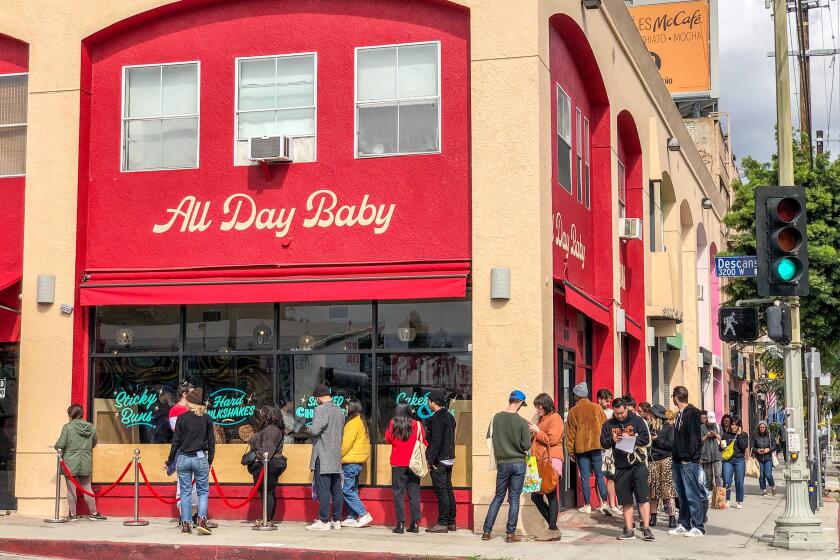Tiny East Hollywood haven Found Oyster feels like a refuge and a party
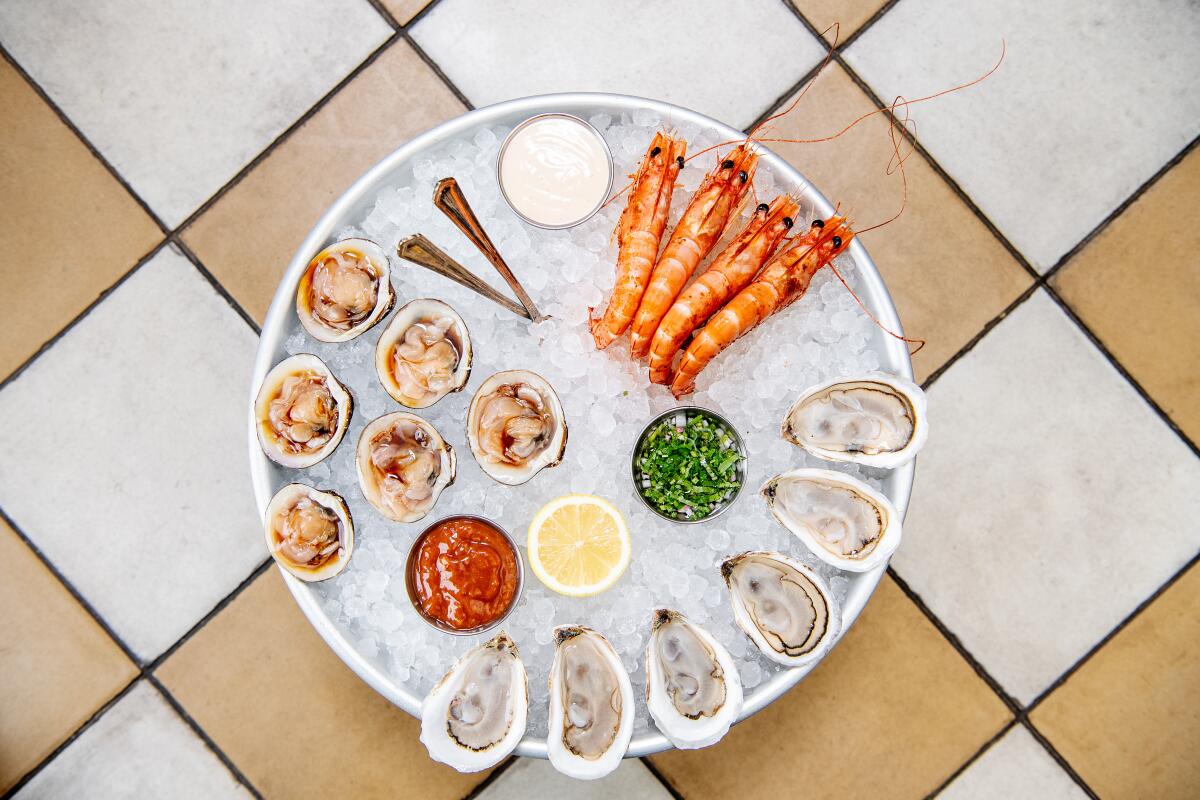
- Share via
A disco ball hangs from Found Oyster’s double-height ceiling, speckling light across the 26-seat room. Shina Williams & His African Percussionists groove from the soundtrack; heads bop while patrons peel prawns and slurp scallops on the half shell. Champagne looks to be the drink of choice for many patrons, followed closely by Coors. On a chilly winter night, when its block of East Hollywood seems especially still, the restaurant feels at once like a refuge and a party.
Chef and co-owner Ari Kolender is always on hand. He moves between the tiny kitchen and a workspace behind the bar, packing lobster meat into small rectangular rolls, ladling milky chowder into bowls and scattering Stilton on top of a wedge salad. A few feet away, general manager Joe Laraja cheerfully, steadily shucks oysters. The batch he’s tackling likely includes a few sent from his parents’ farm in Orleans, Mass.
“This is JoAnne’s recipe for mignonette,” he says, referencing his mom, as he delivers them splayed over ice.
Some Los Angeles-area seafood restaurants are designed for boisterous moods — the seaside ebullience of Fishing With Dynamite in Manhattan Beach, the West Hollywood rowdiness of Connie & Ted’s with its sprawling, Googie-esque dining room. Found Oyster’s tiny size facilitates quieter, head-to-head conversations. It’s an excellent place to let the weight of the day roll off.
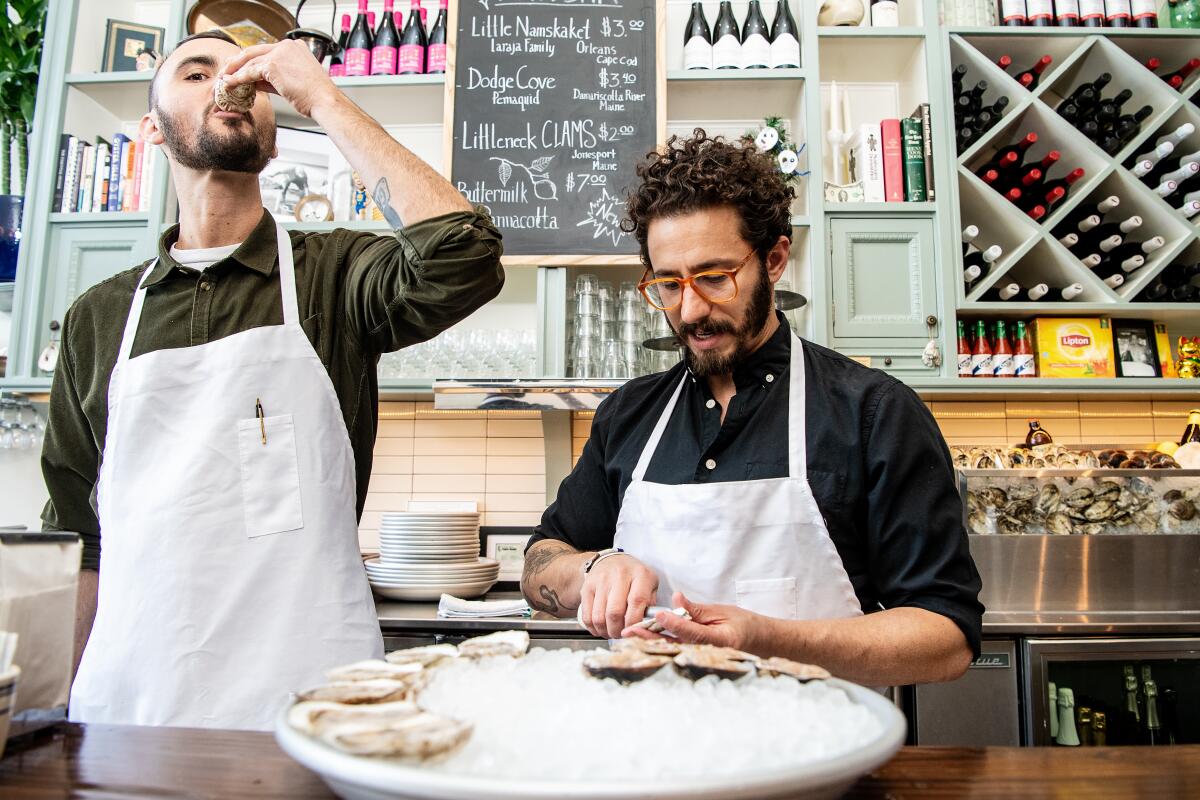
The restaurant, narrow and tall, is sandwiched between a vegan grocery store and Mestizo Cafe; the Church of Scientology’s “Big Blue” building looms up the street. Found Oyster brims with stripped-down charm: beige and white checkered tiles, with a cluster of abstract art in one corner; shelves climb the walls, doubling as storage bins, crammed with bottles, books, stacks of tortillas and jarred spices. Tables for two line one wall — though the real action is at one of the dozen stools along the knotty, polished wooden bar.
Despite the name, I wouldn’t label this explicitly as an oyster house: The restaurant stocks only two varieties, usually from New England, and they are enough. Match them with peel-and-eat prawns (your hands will smell like Old Bay afterward) and a plate of albacore crudo in a pool of olive oil and dotted with capers and onions — an ode to the raw fish stylings of Swan Oyster Depot in San Francisco. Oysters reappear fried, in crinkled bundles of batter and expertly broiled in pools of Espelette butter.
Kolender’s fluency in the medium shows up more explicitly elsewhere — most meaningfully, perhaps, in his reconceptualization of lobster bisque. The truth about this Continental-era relic: It’s a bog of monotonous richness; there is never enough lobster to make it worthwhile.
This kitchen smartly reverse-engineers it as a lobster roll. He boils down a stock made from lobster shells, fortifies it with cream and folds in cayenne for heat, carrot juice reduction for color and lobster coral for harmonics. Hunks of tail meat are packed into a just-toasted bun; the condensed bisque sauce perfumes but doesn’t overwhelm the lobster — the balance of ingredients succeeding at last. (If you want actual soup, the clam chowder is smoky and chunky with seafood.)
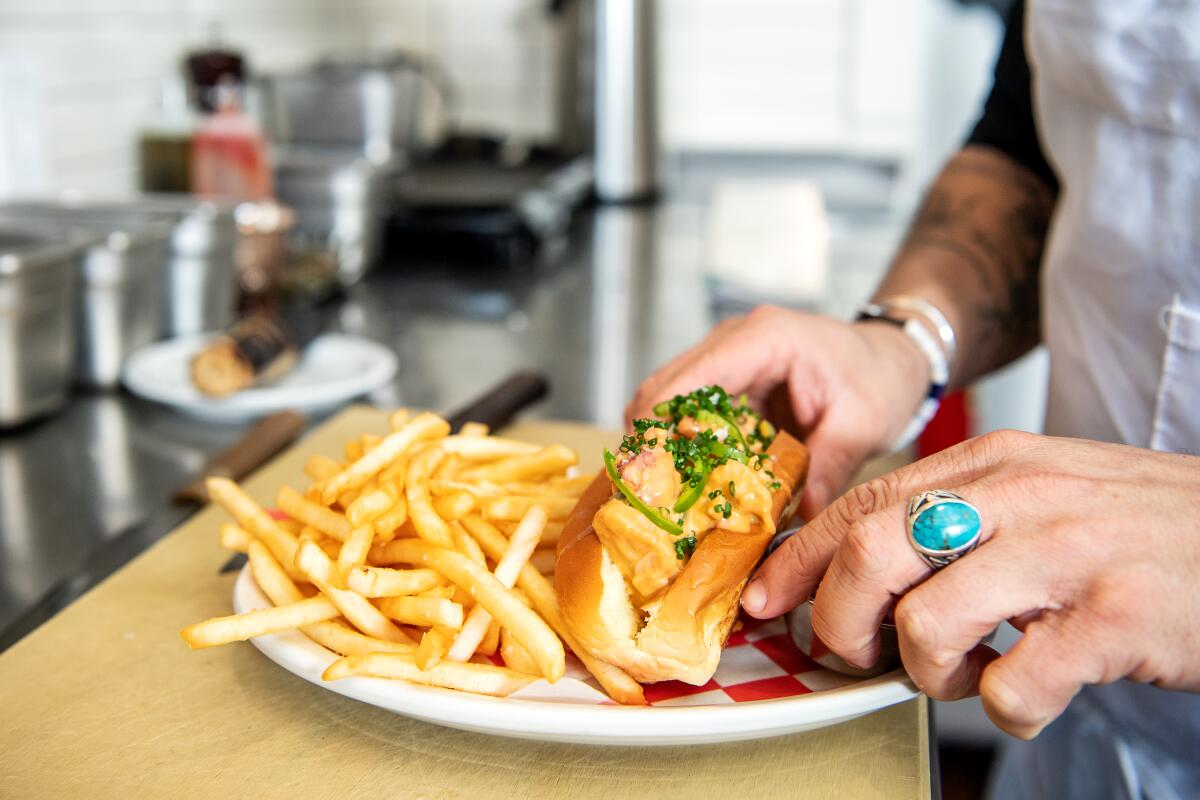
Some dishes are subtler but no less compelling. A tostada is overlaid with raw scallops lit up with yuzu kosho and potent basil; the presence of apple slivers plays up the scallops’ funky sweetness. If razor clams are available, they’ll be broiled in a fragrant blend of sumac, black sesame, fennel pollen and fried garlic. I’ve had gritty razor clams, a true buzzkill, at some of the toniest restaurants in town. These are immaculate.
Fun, caloric whimsies also pop up among the short menu’s dozen-plus items. An experiment with hush puppies became a griddled clam johnnycake glossed with bacon-laced tartare sauce and trout roe. A clever mashup of artichoke dip and brandade comes with a crusty cheese crown and a couple fistfuls of tortilla chips. (So stealing the idea for this year’s Oscars gathering.)
For such an unassuming space, Found Oyster’s food makes consistently bold statements. Seafood, as it turns out, is Kolender’s métier. Life steered him that way. His first job after culinary school was at Providence, helmed by sustainable-fishing crusader Michael Cimarusti. In 2012 Kolender circled back to Charleston, S.C., his hometown, for a stint at the Ordinary, a gleaming seafood hall in a grand renovated bank. He then led the kitchen at the Holy City’s magnetic Leon’s Oyster Shop, where the fried chicken is as righteous as the buttery char-grilled bivalves. Kolender returned to Los Angeles two years ago to run Hayden, a Culver City seafood bar and wine shop; it closed last June and he started Found Oyster in November.
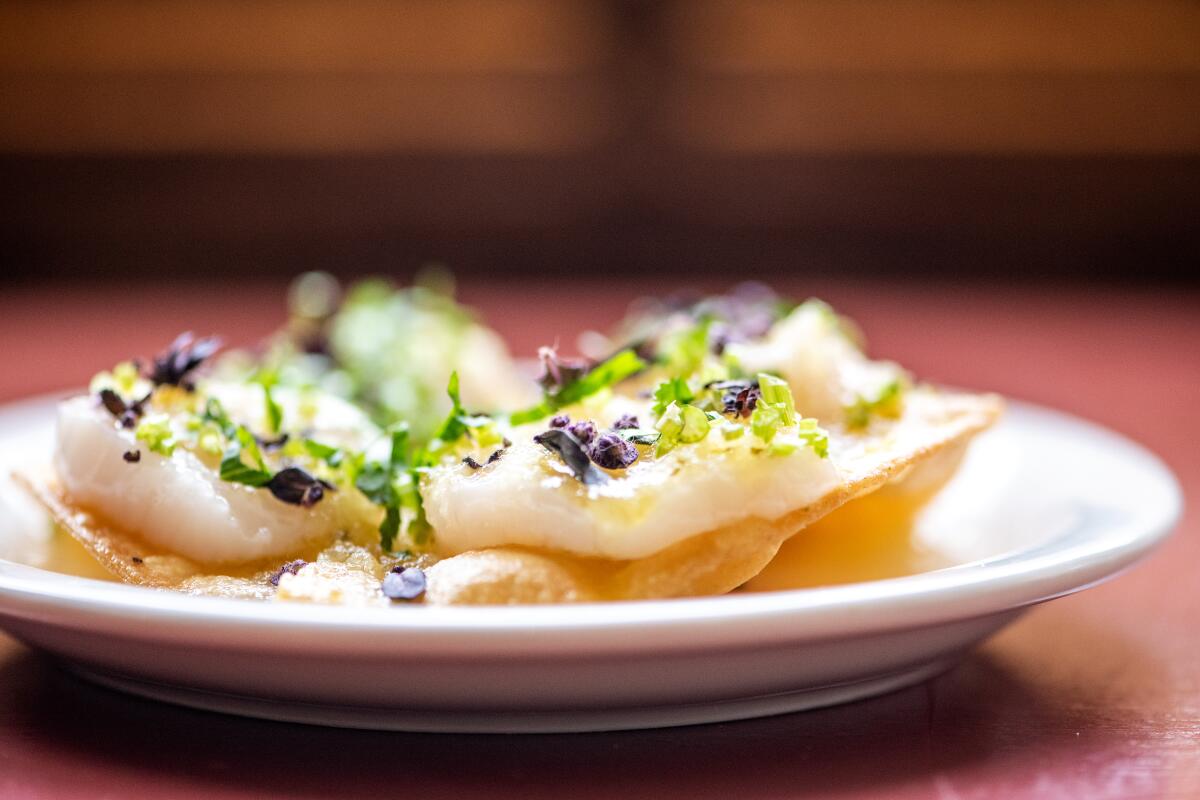
True to its chef’s bicoastal culinary background, Found Oyster doesn’t hew to one region for seafood: It might not lean toward West Coast favorites (Kolender favors blue crab over Dungeness) but the venture doesn’t attempt an approximation of a salty-aired East Coast clam shack either.
I remember his cooking at Leon’s in Charleston: It was irresistible, big-personality food for the masses. Found Oyster has an innate, intimate sense of occasion; partly it’s the quality of the seafood, and also the dishes show more individualism, more restraint. That strikes me not as simply adapting to the size of the space but as growth in Kolender’s talents. Now he’s fashioning his own nautical geography, pulling from whatever traditions and seasonal finds most resonate with him. The approach serves the neighborhood and the city well.
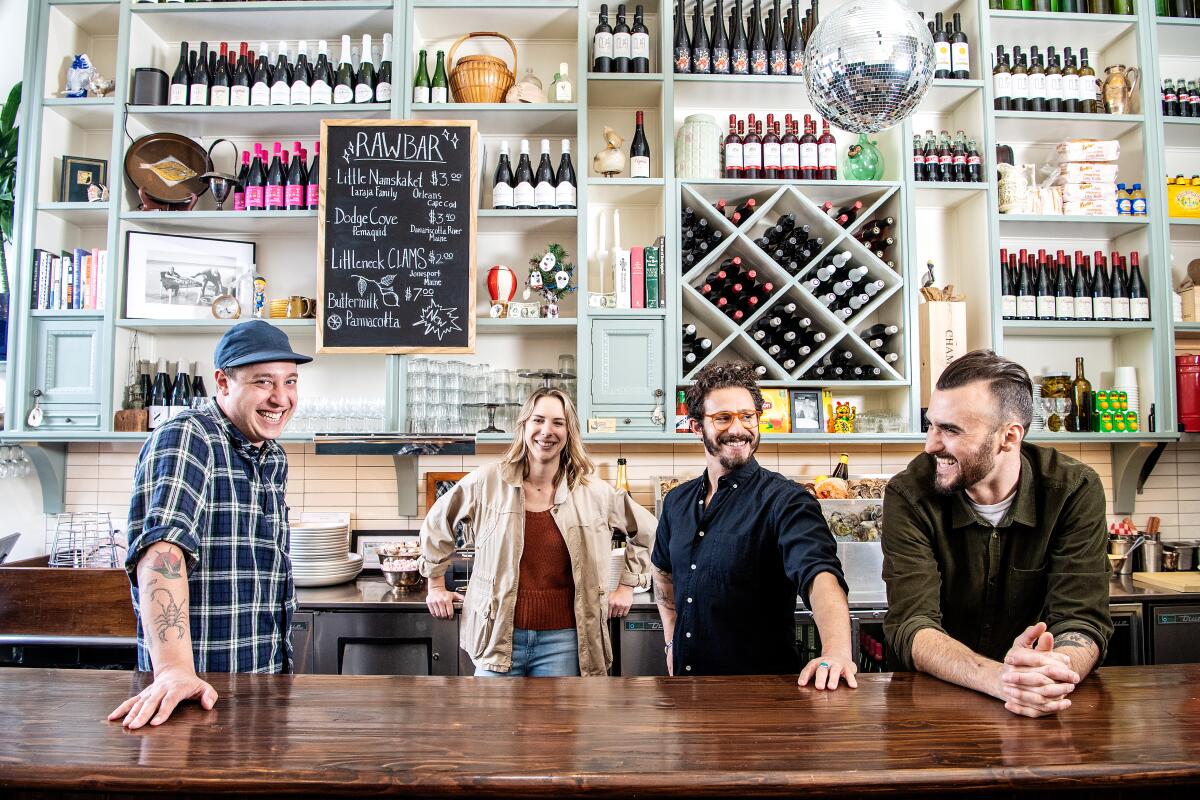
Found Oyster
Location: 4880 Fountain Ave., Los Angeles, (323) 486-7920, foundoyster.com
Prices: Smaller plates $5-$16, larger plates $25-$28.
Details: Credit cards accepted. Wine and beer. Street parking. Wheelchair accessible.
Recommended dishes: raw oysters, clam chowder, razor clams (when available), scallop tostada, wedge salad, lobster bisque roll.
More to Read
Eat your way across L.A.
Get our weekly Tasting Notes newsletter for reviews, news and more.
You may occasionally receive promotional content from the Los Angeles Times.









